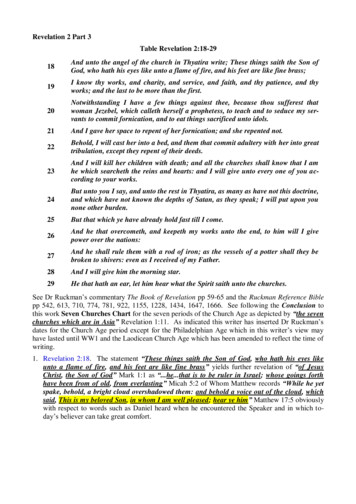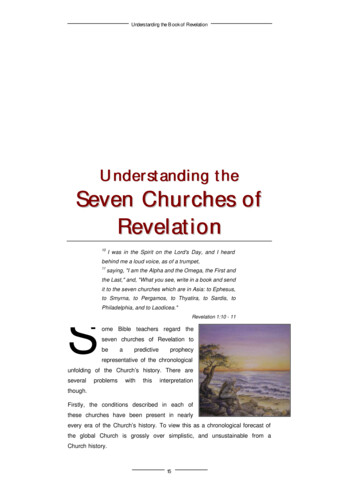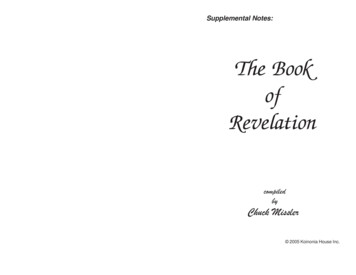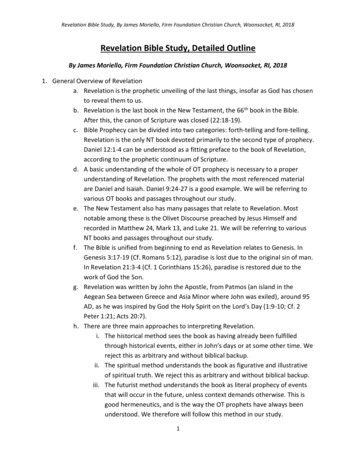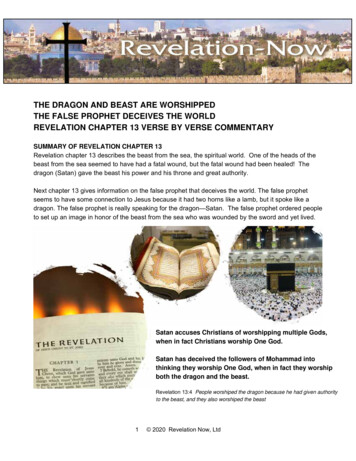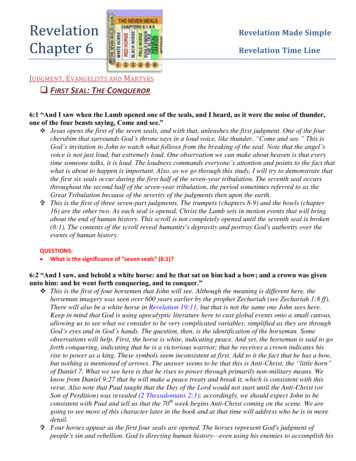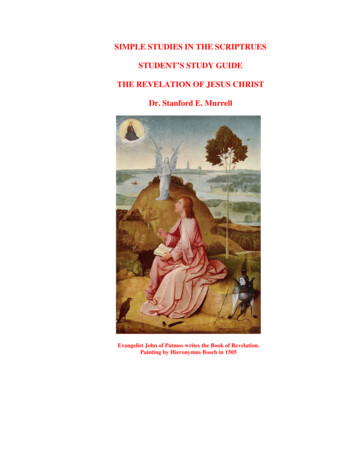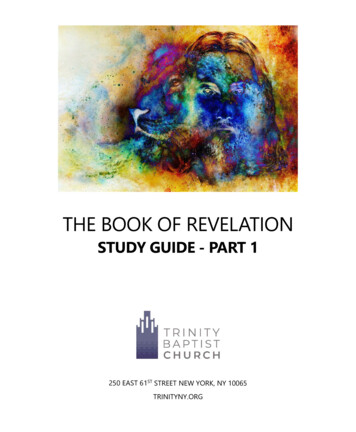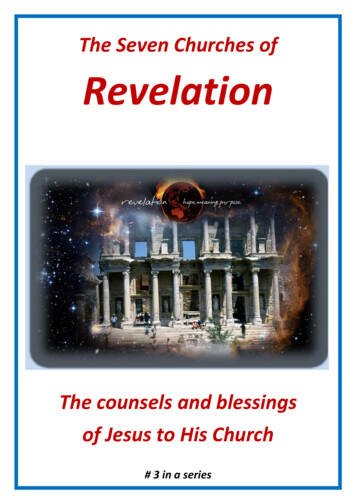
Transcription
The Seven Churches ofRevelationThe counsels and blessingsof Jesus to His Church# 3 in a series
IntroductionIn our modern electronic age, we have an efficient communication system that enablesus to contact any part of the world almost instantly. In the days of the Apostle John,there was no internet, email or Skype. At best, the mail system sometimes took manymonths before a message could be delivered. To add to the problem of communication,not everyone could write and if they could, the cost of writing materials was prohibitiveto many people. When a message was received, it was looked upon as a major and extraspecial event.Just imagine you were living in the year 95AD in Western Turkey. You’ve come toworship in the church on Saturday morning, the day of worship in those times. While youare in church, the church elder announces that he has a letter from Jesus Christ. Thiswould indeed be a moment of excitement. You can hardly wait to hear the message.Your curiosity would be intense. The book of Revelation is this letter from Jesus and weare still able to read it 2,000 years later.Question 1: Can you see how the book of Revelation is a letter from Jesus to Christianstoday as well as in the first century?Overview of Session #3 (Revelation chapters 2 & 3)1.2.3.4.5.The number 7 in the book of RevelationThe seven messages to the seven churchesThe “Great Controversy” between Christ and SatanA History of ChristianityThe promises of Jesus Christ to the Seven Churches1. The Number Seven in the Book of RevelationFirst of all, we want to examine the significance of the number seven in Revelation. Thisnumber occurs frequently throughout the book. Note the following examples – Seven Churches - Rev 1, 2 & 3Seven Spirits - Rev 1 & 4Seven Lampstands - Rev 1Seven Blessings – Rev 1, 14, 16, 19, 20 & 22Seven Seals – Rev 6 - 8Seven Trumpets – Rev 8 - 11Seven Thunders – Rev 10Seven Plagues – Rev 162
What is the significance of number 7?The reason why it is repeated often has to do with the Hebrew language which wasspoken by the Jewish people and also used in the original writing of the Old Testament.The number 7 in Hebrew means completion, perfection or totality. It is indeed God’sspecial number in the Bible. The Hebrew word for seven is “Sheva” which carries themeaning of completion and perfection. There are other parts of the Bible where thisword is used such as in the opening book of Genesis. Here we read that God created theworld in six days and rested on the seventh, calling this final day of the week a rest dayand a holy day by placing a special blessing on it. The seventh day was called God’s holyday.By comparison the number 6 is associated with humankind. At creation, the man andwoman were created on the sixth day. In Revelation 13, the number 666 is said to be thenumber of a man. This subject will be studied more closely in future lessons.In Revelation chapters 2 & 3 we see 7 messages that are sent to these 7 specific churchesbut they are meant for all of God’s churches on earth from these early times, even to ourtime today. There are special messages and blessings to be received by all followers ofJesus.The main street of Ephesus – once lit by lights on both sidesQuestion 2: What is the meaning of number seven in the Hebrew language?Question 3: Why do you think it is a number of significance for God?3
2. The Seven Messages to the ChurchesIn the messages to the churches, there is a pattern. Each church is –1.2.3.4.5.6.7.Named by JesusGiven a partial description of Jesus (From chapter 1)Known by Jesus for special character traitsCommended by Jesus for something specificRebuked by Jesus for something specificCounselled by Jesus to act in a specific wayPromised by Jesus a specific reward if they remain faithful.From this list, it is obvious that Jesus knows each of these churches intimately just like Heknows each one of us with our weaknesses and strengths. He is interested in ourcharacter development and desires to have a close relationship with each one of us toprepare us for eternity. In the vision of Jesus standing among the lampstands is a pictureof Jesus mingling intimately with His beloved people. The desire of Jesus today is that weallow Him to guide our life that He might safely lead us to His kingdom.A special message is tailored to each specific church. A blessing comes to us today as weexamine each message to these churches. They are located in chapters 2 and 3 ofRevelation.Question 4: What do you think was the motive of Jesus in giving these strong messages tothe churches?The Seven Churches of Revelation Location4
3. The “Great Controversy” Between Christ and SatanIn four of the seven messages to the churches, there is a mention of a being called Satan.Satan is an angel that rebelled against God and was expelled from heaven by God alongwith the angels who gave their allegiance to Satan. They were cast out of heaven to theearth and after successfully deceiving Adam and Eve have continued their rebellionagainst God. Satan’s power is referred to in four of the seven messages – To the city of SardisTo the city of PergamumTo ThyatiraAnd to PhiladelphiaFrom very early in Revelation, we see this evil force at work within the churches opposingGod and His faithful followers. This ‘good versus evil’ is a continual theme throughoutRevelation and peaks in chapters 12 – 14. Indeed, a spiritual battle is continually inprogress. It is a battle of the mind with the forces of evil labouring to gain allegiance.Then in contrast, we have the convicting and appealing Spirit of God pleading withpeople’s hearts in order that He might save their souls. The battle rages on in the mindsof individuals, in churches and in all places of planet Earth throughout history.Understanding this battle enables us to realize why there is so much evil in the world.There is a constant striving for the allegiance of the mind. Whether we like it or not, wepersonally are caught up in the very midst of this battle.Satan and his angelscast out of heavenQuestion 5: Can you see how you are personally involved in the battle between good andevil?Question 6: Would you like to learn more about this subject?5
4. The History of ChristianityEach of the messages to the churches has a parallel application to the history of theChristian church over the last 2,000 years. This is the period between Christ’sresurrection and His promised Second Coming. These are the times that match the maintheme of the messages to the churches. Ephesus was a passionate church and so was the Christian church in generalbetween 30 – 100 AD. Smyrna was a persecuted church and so was the Christian church between 100 –313AD. Pergamum was a compromising church and so was the Christian church between313 – 538 AD. Thyatira was known as a corrupt church which characterizes the Christian churchbetween 538 – 1560s. Sardis was regarded as a lifeless church just like the church between the 1560s –1790s Philadelphia was the church of revival paralleling the church between the 1790s –1840s. Laodicea was an indifferent church representing the church from the 1840s totoday.The text of Revelation does not specifically say that the messages of the churches arewritten as history in advance. However, the description of the church during theseperiods is remarkably similar to the language used by Jesus to describe each of the sevenchurches. Jesus hates sin but He loved the churches in the first century. Likewise, He stillloves the church in our day even though it falls short of perfection. To say He loves thechurch also means He loves us each one, for it is individuals that make up the church.Jesus makes the passionate call to us each one –Revelation 3:20 “Behold I stand at the door and knock. If anyone hears my voice andopens the door, I will come in to him and dine with him and he with me.”The lukewarm watersof Laodicea6
Question 7: Why do you think Jesus is so interested in knocking at our heart’s door?5. The Promises of Jesus to the ChurchesThe churches may have shortcomings but Jesus has some wonderful promises to thosewho remain faithful and in His strength become overcomers. These are the promises l To Ephesus He promises –Revelation 2:7 To him who overcomes I will give to eat from the tree of life, which is in themidst of the Paradise of God.ll To Smyrna He promises –Revelation 2:11 He who overcomes shall not be hurt by the second death (Punishment ofthe wicked).lll To Pergamum He says –Revelation 2:17 To him who overcomes I will give some of the hidden manna to eat. I willgive him a white stone, and on the stone a new name which no one knows except himwho receives it (The hidden manna refers to spiritual food from God. The white stone is asign of acquittal or forgiveness and the new name represents the character of theovercomer).lV To Thyatira He promises –Revelation 2:26 And he who overcomes, and keeps my works until the end, to him I willgive power over the nations.V To Sardis He promises –Revelation 3:5 He who overcomes shall be clothed in white garments, and I will not blotout his name from the Book of Life; but I will confess his name before My Father andbefore His angels.Vl To Philadelphia He promises –Revelation 3:12 He who overcomes, I will make him a pillar in the temple of My God, andhe shall go out no more. I will write on him the name of My God and the name of the cityof My God, the New Jerusalem, which comes down out of heaven from My God. And I willwrite on him my new name.Vll To Laodicea He promises –Revelation 3: 21 To him who overcomes I will grant to sit with Me on My throne.7
Towards the end of the Book of Revelation, we see how these promises will be fulfilled toall true believers. God not only talks about promises - He also delivers. He is a promisekeeping God. He will indeed do what He says He will do.Question 8: How do you feel about these promises of God?Question 9: What is the benefit of eating from the Tree of Life?Question 10: What is meant by “the second death” (Rev. 2:11)?Question 11: Is your desire to have your name written in the Book of Life (Rev. 3:5)?8
theme of the messages to the churches. Ephesus was a passionate church and so was the Christian church in general between 30 - 100 AD. Smyrna was a persecuted church and so was the Christian church between 100 - 313AD. Pergamum was a compromising church and so was the Christian church between 313 - 538 AD.



